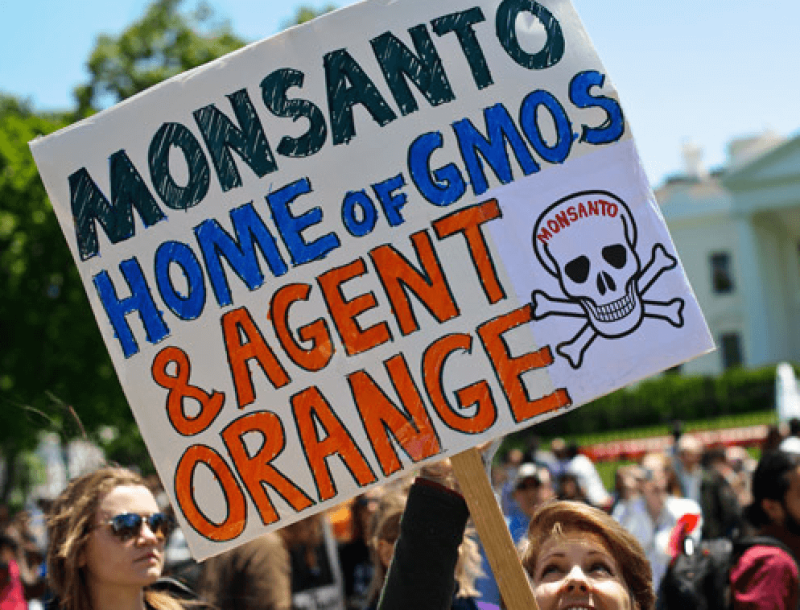Agent Orange was created for the U.S. military to destroy plants in Vietnam and the demilitarized zone in Korea during the 1960s through 1970s Southeast Asian conflict. About 24 percent of South Vietnam was sprayed with Agent Orange, killing plants that could provide cover or food for the Viet Cong and other enemy forces. It worked very well — almost too well.
The formulation, consisting of the herbicides 2,4-D and 2,4,5-T, was at concentrations several hundred times that of normal agricultural use. Its residue is still causing health problems in Vietnam, and has affected the health of U.S. and other veterans of the war.
In the United States, anti-GMO activists have latched onto the fact that 2,4-D was a “component” of Agent Orange and is therefore too dangerous to be approved for agricultural use. Last year, for example, when the U.S. Environmental Protection Agency approved Dow Chemical’s formulation, Enlist Duo, consisting of 2,4-D and glyphosate, for use on corn and soybeans genetically modified to be 2,4-D-resistant, The Center for Food Safety pointed to Agent Orange:
2,4-D, produced by Dow Chemical, was a component of “Agent Orange,” the toxic defoliant used in Vietnam. It is the 7th largest source of dioxins in the U.S. 2,4-D and other herbicides of its class have been independently associated with deadly immune system cancers, Parkinson’s disease, endocrine disruption, and reproductive problems, with children at particular risk.
Food Democracy Now! went even further, proclaiming that the U.S. government had just introduced “’Agent Orange’ 2,4-D GMO crops!”
And not to be outdone, Liz Anderson, of GMO-free Prescott (Arizona), equated 2,4-D with the toxic chemical dioxin in a blog in Natural Healing News:
The Dow Chemical Company, another big player in the GMO market, recently petitioned the USDA to approve the use of dioxin, as they are developing a “dioxin-resistant hybrid.” The huge industrialized farms will be able to keep their crops pristine by sloshing the weeds with Agent Orange.
Agent Orange and GMOs
Production of Agent Orange was discontinued in the 1970s as the Vietnam War drew to an end and stockpiles were destroyed. At the weapon-grade levels it was used during the war, it probably would have killed any plant, genetically modified or not.
What also has been missing from the claims of activists who tried to confuse 2,4-D with Agent Orange and dioxins is the fact that the Agent was made of distinct chemicals, with distinct properties. And 2,4-D was not the problem.
Agent Orange was a combination of two herbicides: 2,4D and another called 2,4,5-T. The toxic dioxin, 2,3,7,8-TCDD was a contaminant only of 2,4,5-T. It was not a byproduct of 2,4-D, although some forms of 2,4-D that weren’t widely used did have some small dioxin contamination. Modern manufacturing methods have eliminated this contamination from today’s 2,4-D.
Some dioxins are very toxic. According to the World Health Organization, “Dioxins can cause reproductive and developmental problems, damage the immune system, interfere with hormones and also cause cancer.” They can also be persistent, with half-lives that can vary from three to five years in sunlight (which breaks down the chemical) to nearly a century in groundwater. The average half-life in the human body is estimated at about 10 years.
But Dow’s Enlist Duo, or any other formulation that includes 2,4-D, does not have dioxins contaminants. In fact, 2,4-D has been declared far, far less toxic than dioxins (what isn’t?), and less even than its wartime Agent Orange formulation.
The International Agency for Research on Cancer (IARC), the hazard research arm of WHO, recently declared that 2,4-D, along with several other pesticides, posed a “possible” risk of cancer, which was a significant step below the “probable” moniker for glyphosate given by IARC and currently incorrectly touted by anti-GMO groups and many media organizations as a higher risk of cancer.
The IARC rating, which measures just the hazard properties of chemicals, foods, or behaviors, did not measure the risk, meaning that they did not consider actual normal exposure to 2,4-D or other chemicals in their decision making. The rating, IARC has pointed out repeatedly, reflects “limited evidence of carcinogenicity in humans and less than sufficient evidence of carcinogenicity in experimental animals.” The IARC announcement has been met with some criticism from agricultural experts and farmers. Ken McCauley is a Kansas grower and past president of the National Corn Growers Association:
I am very concerned that these IARC reviews will be misinterpreted by the general public. Herbicides like 2,4-D are essential to modern farming, helping us produce more food, control weeds, use less resources and reduce our costs, which ultimately helps the consumer. Based on all the studies and government reviews, we believe 2,4-D herbicides are safe or we wouldn’t be using them.
As we have noted in various Genetic Literacy Project articles, no farmer is excited about using pesticides. But 2,4-D is less toxic than most herbicides, and it’s not the same as the deadly defoliant cocktail used in wartime Vietnam.
Andrew Porterfield is a writer, editor and communications consultant for academic institutions, companies and non-profits in the life sciences. He is based in Camarillo, California. Follow @AMPorterfield on Twitter.































